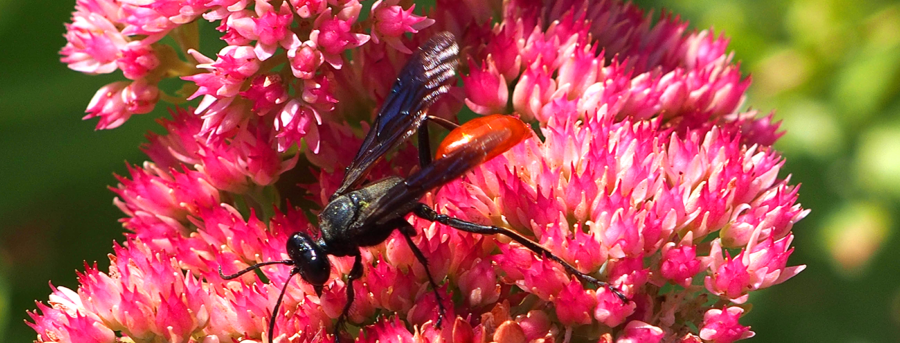This wasp, which I believe is Prionyx thomae (P. parkeri and P. canadensis are similar), seemed very interested in a flowering sedum. It appeared to be collecting nectar, though conceivably it was just watching for prey.
Fairly common in the western U.S. and south to Argentina, Prionyx thomae is a solitary wasp. The female kills prey such as grasshoppers by injecting them with venom, then carries the remains back to a nest where it can serve as a host for its offspring. Because the stinger is not barbed like that of a bee, it doesn’t break off in its victim, and the female can inflict multiple stings. (The male lacks a stinger entirely.)
If my insect identification skills were better I might be able to tell if this is a male or a female. Guidelines from Bohart, R.M., Menke, A.S., 1963, A Reclassification of the Sphecinae: With a Revision of the Nearctic Species of the Tribes Sceliphronini and Sphecini:
- Male—Average length 12 mm; head and thorax black, gaster red, tergites rarely with darker markings; wing clear in cellular area, darker beyond; erect hair of head and thorax white; flagellum as in figure 103; sternite VII entire
- Female—Average length 13 mm; pronotal lobe and vertex, scutal furrows, mesopleura behind pronotal lobe, and pleura above mid and hind coxae with appressed silvery pubescence; labial palpus generally not visible in museum specimens, much shorter than maxillary palpus
The female carries its prey, sometimes larger than itself, to a chamber it excavates at the end of a tunnel that it digs for the purpose, then lays its egg.
Bug Eric (my best source) describes such a wasp grappling with its grasshopper prey.

